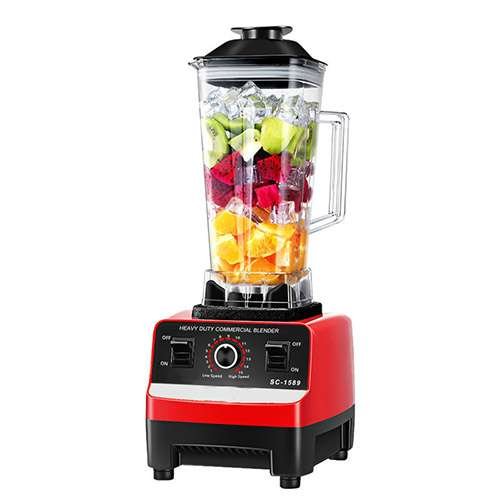1. Введение
На современных кухнях блендеры стали незаменимыми помощниками в приготовлении пищи. Они не только помогают нам быстро приготовить разнообразные деликатесы, но и экономят время и энергию. Однако на рынке представлено множество типов блендеров, среди которых особенно распространены коммерческие и бытовые блендеры. В этой статье мы подробно расскажем о различиях между коммерческими и бытовыми блендерами, чтобы помочь Вам выбрать тот продукт, который подходит именно Вам.

2. Сценарии использования и требования к производительности
Коммерческие блендеры
Коммерческие блендеры в основном используются в коммерческих заведениях, таких как рестораны, отели и пекарни. Они используются часто и имеют продолжительное рабочее время. Поэтому коммерческие блендеры обладают следующими эксплуатационными характеристиками:
(1) Высокая мощность: Коммерческие блендеры обычно обладают высокой мощностью, чтобы обеспечить стабильный и эффективный эффект смешивания в условиях непрерывной работы.
(2) Большая емкость: Коммерческие блендеры обычно имеют большую емкость, чтобы удовлетворить потребности в смешивании большого количества ингредиентов.
(3) Прочность: Коммерческие блендеры изготовлены из высококачественных материалов, долговечны и подходят для длительной непрерывной работы.
Бытовые блендеры
Бытовые блендеры в основном подходят для домашних кухонь и используются относительно редко. Бытовые блендеры обладают следующими эксплуатационными характеристиками:
(1) Умеренная мощность: мощность бытовых блендеров относительно невелика, что удовлетворяет повседневные потребности домохозяйств.
(2) Умеренная мощность: Мощность бытовых блендеров умеренная, что подходит для приготовления небольших партий пищевых ингредиентов в домашних условиях.
(3) Высокая мобильность: бытовые блендеры имеют небольшие размеры, их легко хранить и переносить.
3. Различия в функциях и аксессуарах
Коммерческие миксеры
Коммерческие миксеры обладают богатым функционалом и оснащены полным набором аксессуаров, в основном включающим следующие функции:
(1) Многофункциональность: Коммерческие миксеры имеют несколько режимов смешивания, например, взбивание яиц, замешивание теста, перемешивание, измельчение и т.д.

(2) Богатый набор аксессуаров: Коммерческие блендеры обычно оснащены разнообразными аксессуарами, такими как взбивалки для яиц, крюки для теста, ломтерезки, измельчители и т.д., чтобы удовлетворить потребности в обработке различных ингредиентов.
(3) Регулируемая скорость: Коммерческие блендеры имеют несколько настроек скорости, которые можно регулировать в зависимости от ингредиентов и потребностей в смешивании.
Бытовые блендеры
Бытовые блендеры имеют относительно простые функции, но могут удовлетворить повседневные потребности семьи. В основном они включают в себя следующие функции:
(1) Основные функции: Бытовые блендеры выполняют такие базовые функции, как смешивание, измельчение и взбивание яиц.
(2) Простые аксессуары: У бытовых блендеров сравнительно немного аксессуаров: как правило, это чашки для смешивания, чашки для измельчения и т.д.
(3) Регулировка скорости: Бытовые блендеры обычно имеют 2-3 настройки скорости, чтобы удовлетворить потребности в обработке различных ингредиентов.
4. Цена и стоимость обслуживания
Коммерческие миксеры
Коммерческие миксеры стоят относительно дорого, но они долговечны и не требуют больших затрат на обслуживание. Ниже приведены характеристики коммерческих миксеров с точки зрения цены и обслуживания:
(1) Высокая цена: Из-за мощной производительности и богатого оснащения коммерческих миксеров, их цены относительно высоки.
(2) Низкая стоимость обслуживания: Коммерческие миксеры изготовлены из высококачественных материалов, имеют низкий процент отказов и относительно низкую стоимость обслуживания.
Бытовые блендеры
Бытовые блендеры доступны по цене, но стоимость их обслуживания относительно высока. Ниже приведены характеристики бытовых блендеров с точки зрения цены и обслуживания:
(1) Доступная цена: Бытовые блендеры имеют умеренную цену и подходят для широкой публики.
(2) Высокая стоимость обслуживания: Бытовые блендеры используются реже, но их легко повредить, и стоимость обслуживания относительно высока.
5. Резюме
Существуют определенные различия между коммерческими и бытовыми блендерами с точки зрения производительности, функциональности, цены и стоимости обслуживания. Как производитель небольших блендеров для кухонной техники, мы рекомендуем потребителям выбирать подходящие продукты в соответствии с их потребностями и сценариями использования.
Если Вы занимаетесь коммерческой деятельностью, рекомендуется выбрать коммерческий блендер, чтобы приспособиться к высокоинтенсивной и длительной работе; если Вы занимаетесь домашним хозяйством, достаточно бытового блендера, чтобы удовлетворить Ваши ежедневные потребности в приготовлении пищи. Надеюсь, эта статья поможет Вам лучше понять разницу между коммерческими и бытовыми блендерами и выбрать тот продукт, который Вам понравится.